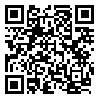Volume 76, Issue 5 (August 2018)
Tehran Univ Med J 2018, 76(5): 326-330 |
Back to browse issues page
Download citation:
BibTeX | RIS | EndNote | Medlars | ProCite | Reference Manager | RefWorks
Send citation to:



BibTeX | RIS | EndNote | Medlars | ProCite | Reference Manager | RefWorks
Send citation to:
Mohammadi E, Kermani S, Amra B. Introduction of low to high frequencies bispectrum rate feature for deep sleep detection from awakening by electroencephalogram. Tehran Univ Med J 2018; 76 (5) :326-330
URL: http://tumj.tums.ac.ir/article-1-8965-en.html
URL: http://tumj.tums.ac.ir/article-1-8965-en.html
1- Department of Bioelectrics and Biomedical Engineering, School of Advanced Technologies in Medicine, Isfahan University of Medical Sciences, Isfahan, Iran.
2- Department of Bioelectrics and Biomedical Engineering, School of Advanced Technologies in Medicine, Isfahan University of Medical Sciences, Isfahan, Iran. ,kermani@med.mui.ac.ir
3- Department of Pulmonology and Somnologist, Bamdad Respiratory Research Center, Isfahan University of Medical Sciences, Isfahan, Iran.
2- Department of Bioelectrics and Biomedical Engineering, School of Advanced Technologies in Medicine, Isfahan University of Medical Sciences, Isfahan, Iran. ,
3- Department of Pulmonology and Somnologist, Bamdad Respiratory Research Center, Isfahan University of Medical Sciences, Isfahan, Iran.
Abstract: (3426 Views)
Background: Accurate detection of deep sleep (Due to the low frequency of the brain signal in this part of sleep, it is also called slow-wave sleep) from awakening increases the sleep staging accuracy as an important factor in medicine. Depending on the time and cost of manually determining the depth of sleep, we can automatically determine the depth of sleep by electroencephalogram (EEG) signal processing. In this paper a new EEG bispectrum based feature is introduced for deep sleep discrimination.
Methods: This cross-sectional study was conducted at Isfahan University of Medical Sciences, Faculty of Advanced Technologies in Medicine, from February to October 2017. In this study a gray scale image was made of electroencephalogram bispectrum amounts and converted to binary image with Otsu’s Thresholding. Then the ratio of white bits in the above of the secondary diagonal to white bits in the down of secondary diagonal (low to high frequencies bispectrum rate) is extracted as a new feature. This feature is an effective method for detecting deep sleep from awakening.
Results: One of the important methods in biomedical signal processing is the use of the power spectrum or signal energy. In sleep studies, energy-related features have also been used to determine the depth of sleep. Low to high frequencies bispectrum rate is able to separate deep sleep from awakening by accuracy of 99.50 percent, while energy-based features as one of the most important approaches to sleep classification do not have this ability.
Conclusion: In this study we show that “Low to high frequencies bispectrum rate" feature has this capability to use in sleep staging. It is not used in previous works. The accuracy obtained in deep sleep separation from the awakening with the introduced feature (99.50 percent) is greater than the accuracy obtained by all the energy-based features (The simultaneous use of the 6 bands energy leads to 99.42 percent accuracy). This feature indicates the ratio of the phase coupling at low frequencies to high frequencies and can be used in all cases where the bispectrum is used (such as determining the depth of anesthesia).
Methods: This cross-sectional study was conducted at Isfahan University of Medical Sciences, Faculty of Advanced Technologies in Medicine, from February to October 2017. In this study a gray scale image was made of electroencephalogram bispectrum amounts and converted to binary image with Otsu’s Thresholding. Then the ratio of white bits in the above of the secondary diagonal to white bits in the down of secondary diagonal (low to high frequencies bispectrum rate) is extracted as a new feature. This feature is an effective method for detecting deep sleep from awakening.
Results: One of the important methods in biomedical signal processing is the use of the power spectrum or signal energy. In sleep studies, energy-related features have also been used to determine the depth of sleep. Low to high frequencies bispectrum rate is able to separate deep sleep from awakening by accuracy of 99.50 percent, while energy-based features as one of the most important approaches to sleep classification do not have this ability.
Conclusion: In this study we show that “Low to high frequencies bispectrum rate" feature has this capability to use in sleep staging. It is not used in previous works. The accuracy obtained in deep sleep separation from the awakening with the introduced feature (99.50 percent) is greater than the accuracy obtained by all the energy-based features (The simultaneous use of the 6 bands energy leads to 99.42 percent accuracy). This feature indicates the ratio of the phase coupling at low frequencies to high frequencies and can be used in all cases where the bispectrum is used (such as determining the depth of anesthesia).
Type of Study: Original Article |
Send email to the article author
| Rights and permissions | |
 |
This work is licensed under a Creative Commons Attribution-NonCommercial 4.0 International License. |





